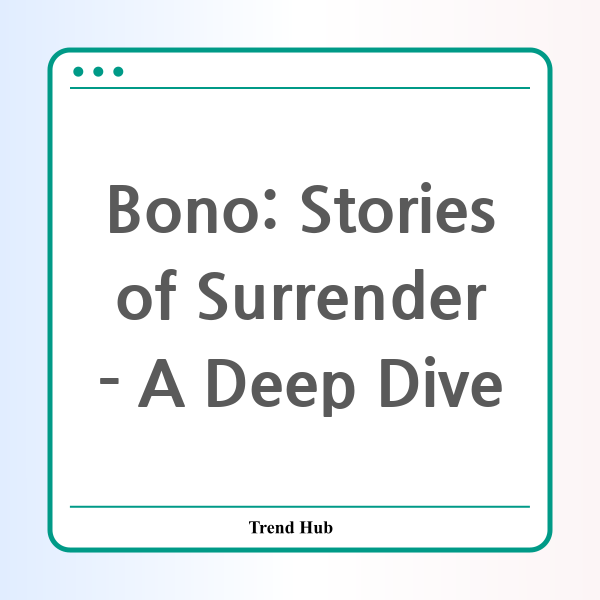* This website participates in the Amazon Affiliate Program and earns from qualifying purchases.

Are you curious about the latest intimate look into the life of one of rock music's biggest legends? Bono's new project, "Bono: Stories of Surrender," streaming exclusively on Apple TV+, offers a fascinating blend of personal storytelling and captivating musical performances. In this blog post, we will explore the themes, style, and overall reception of this highly-anticipated release.
Exploring Celebrity and Identity
Bono, known for his commanding stage presence and impactful lyrics, steps into a more vulnerable role in this film. The project is not merely a concert film; it's a retrospective journey through his life, inspired by his memoir of the same name. As Bono himself puts it, writing a memoir is a deep dive into self-reflection; however, translating that memoir into a visual experience raises the stakes even higher. Here, Bono invites viewers into his world of celebrity and personal history, providing moments of humor, pain, and ultimately, a glimpse of the man behind the rock star persona.
The film opens with a poignant account of Bono's cardiac surgery in 2016, setting the stage for a narrative that intertwines his health scares with the heart of his storytelling. He humorously describes his heart as "eccentric"—a fitting metaphor for his larger-than-life character.
Musical Accompaniment – A New Take on U2's Classics
In what can be seen as a nod to fellow rock icon Bruce Springsteen, who similarly translated his memoir into a Broadway show, Bono adapts his reflections into a concert format. However, unlike typical U2 performances, he collaborates with a unique trio of musicians: keyboardist Jacknife Lee, cellist Kate Ellis, and harpist Gemma Doherty. This fresh arrangement breathes new life into classic U2 songs like "Sunday Bloody Sunday" and "Beautiful Day," demonstrating that even longstanding rock anthems can evolve and adapt.
The film also features insightful anecdotes, such as Bono's humorous interactions with legendary tenor Luciano Pavarotti, which add depth and color to his storytelling. This personal touch is reminiscent of the memoir's style, rife with name-dropping yet revealing, as he shares the influence of family, particularly the legacy of his late parents, on his life and career.
Visual and Directional Innovation
Directed by Andrew Dominik, the film benefits from his cinematic expertise, blending concert footage with intimate reflections. The use of monochrome cinematography adds an artistic layer that elevates the viewing experience beyond standard concert documentation. With clever transitions, such as panning from the audience to the skyline of Sorrento, Italy, the film captures the duality of Bono's public persona versus his private struggles, making it a visually compelling experience.
Throughout the film, Bono's self-awareness shines through as he examines the tension between his lavish lifestyle and his long-standing activism. This theme resonates more than ever in today's world, inviting viewers to question their own roles and responsibilities.
Conclusion: A Rewarding Experience for Fans
Overall, "Bono: Stories of Surrender" is a rich tapestry of storytelling that weaves together music, personal history, and profound reflection. It may not appeal to those who harbor a disdain for Bono's larger-than-life personality, but for those willing to embrace it, the film offers an engaging and rewarding experience. It invites fans and newcomers alike into the world of a man who has not only witnessed but also shaped the landscape of rock music.
If you haven't yet, be sure to check it out on Apple TV+ and delve into the captivating journey of one of rock's most iconic figures.
* This website participates in the Amazon Affiliate Program and earns from qualifying purchases.